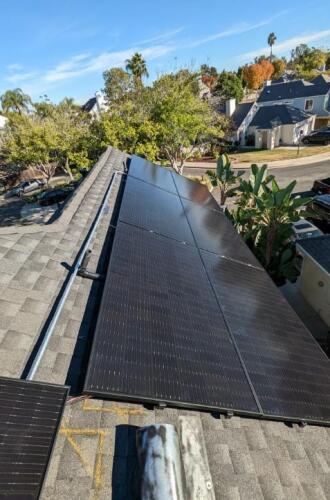The uncertainty clouding California’s solar marketplace could be settled this week as regulators consider a proposal that changes the rules for electricity generated by rooftop solar.
The California Public Utilities Commission (CPUC) is considering a plan that slashes the subsidy for new solar system owners.
“We think rooftop solar is very important," said Matt Baker, the director of the Public Advocates Office at the CPUC. “Our concern was how (to) fund it.”
The proposed update to the state’s net energy metering rules (NEM) does not include the investor-owned utility’s call for steep, mandatory grid connection fees for solar owners.
But the plan does slash the value of electricity produced on rooftops. That means it will take longer to recover the thousands of dollars homeowners spend to install solar panels.
Regulators hope that higher rates during peak usage periods — between 4 p.m. and 9 p.m. — convince customers to add batteries to their solar-only systems or to consider pairing solar and batteries for new installations.
“The proposed decision creates a very, very generous incentive, using actual costs, to create an incentive system to pair a solar system with a battery," Baker said. "And I should add, that’s exactly what we need right now.”
Baker said if existing solar-only installations got batteries to store power generated in the daytime, the state could add eight gigawatts of power to the grid.
That virtual power plant would keep California from having to fire up polluting natural gas plants as the sun sets on solar panels.

The proposed decision says a solar and battery system could save customers an average of $136 a month, allowing them to recoup the cost of installing the system in nine years.
“California’s eye-watering rates are the other part of the equation that deals with payback,” Baker said. “And if you live in San Diego, you have the highest rates in California. And 10% to 20% of that high rate is just the NEM subsidy to customers.”
The Public Advocates Office says existing solar owners get a rate benefit that can earn them up to six times the value of their initial investment.
“If the question is, 'Is it less generous than what there is?' Yes,” said Mike Campbell, a rate specialist at the CPUC Public Advocate’s office. “'Is the amount of generosity we have currently reasonable?' No.”
Part of California’s rate problem is tied to how subsidies are paid for.
The Public Advocates Office would prefer to see an up-front installation credit that the state pays once instead of an open-ended rate subsidy that does not cap benefits for those who install solar for 20 years.
The proposed changes don’t sit well with solar backers.
Solar supporters have worked hard for over a year to keep existing incentives so the state can double the number of solar households to three million by 2030.
Advocates are optimistic the CPUC can still make changes.
“We’ve managed to build a statewide and local coalition of cities, elected officials, nonprofits, churches, schools, climate justice organizations and we’ve been able to successfully advocate for changes in previous proposals,” said Karinna Gonzalez of Hammond Climate Solutions Foundation.

The new plan dropped the so-called solar tax, a mandatory grid connection fee, and it also does not include a $600 million equity fund that was in last year’s rejected proposal.
That was a subsidy designed to bring solar to low-income households and communities of color.
Solar and community advocates say keeping solar unaffordable for low-income residents keeps power in the hands of a few large utilities.
“In order to address equity, you have to intentionally address inequity,” said Eddie Price of the community group Grid Alternatives. “And rooftop solar is a way to do that. You allow us to participate in our own life here, right? As well as helping the planet and helping the grid, but they’re trying to take all that away.”
Price also rejects utility-backed arguments that the current solar subsidy falls unfairly on the bills of residents without solar.
A utility-funded group, Affordable Clean Energy For All, has long argued that solar owners do not pay their fair share to maintain the grid, costs that are included in the price of electricity bought from a utility.
Meanwhile, the California Air Resources Board says the state needs to quadruple the amount of solar-generated electricity by 2045 to hit the state’s carbon neutrality goals.
Some question whether this new subsidy structure will do that.
“When we slow this down to a trickle, then we slow down the movement, this development, the improvement we’ve been trying to achieve for the last 20 or 30 years,” said Wally Arida, a San Diego solar installer for the company Powur.
He said cutting the value of electricity generated by rooftop solar panels by 75% will slow solar installations.

That could also shrink the solar industry workforce.
“This is very inconsistent with what they’re trying to do,” Arida said. “Because by putting in this new mandate, they are basically trying to cut the number of residential solar installs. And that is not good for the industry at all. It’s not good for the industry; it’s not good for homeowners.”
Regulators will discuss the second proposal to revise net energy metering on Thursday.
The CPUC can adopt, reject, or tweak the measure or a commissioner could introduce a different option. Any action requires a majority vote from the five-member panel.
-
The uncertainty clouding California’s solar marketplace could be settled this week as regulators consider a proposal that changes the rules for electricity generated by rooftop solar. In other news, Baja California prosecutors this week sentenced two cartel hit men to 25 years for the murder of journalist Margarito Martinez. Plus, we take you to San Diego's only nonprofit cat lounge.
-
We speak to Councilmember Kent Lee, who was sworn in Monday to represent the city of San Diego’s District 6. This includes Mira Mesa, Kearny Mesa, most of University City, Sorrento Valley and portions of Scripps Ranch. Plus, the uncertainty clouding California’s solar marketplace could be settled this week as regulators consider a proposal that changes the rules for electricity generated by rooftop solar. And, to fight climate change and meet renewable energy goals, the Biden Administration has championed the opening up of federally-owned desert lands in California to develop massive renewable energy projects, like industrial-scale solar.










